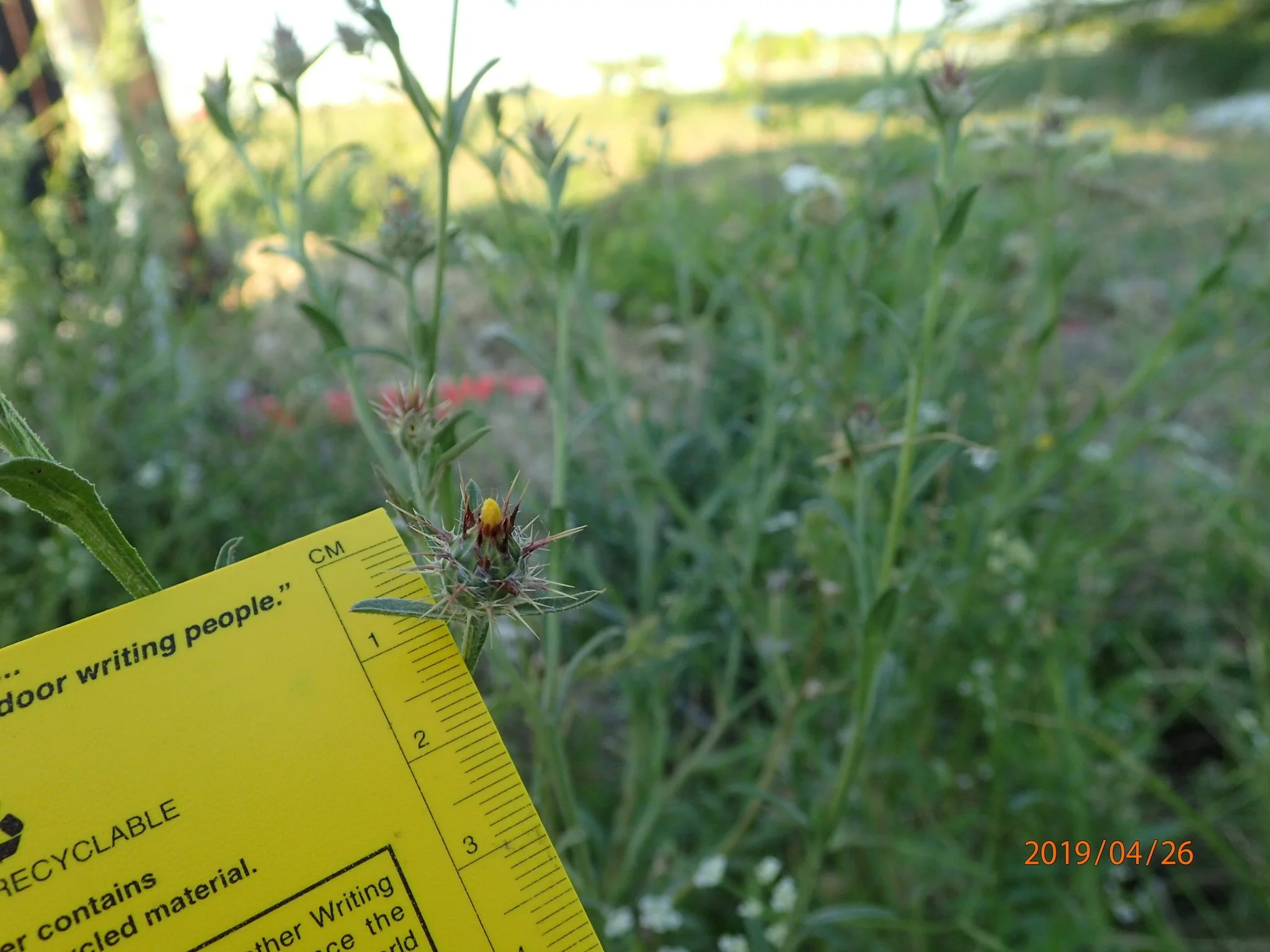Maltese Star-Thistle
A Foreign Plant in Texas Soil
Malta Star-thistle on rangeland off Lime Kiln Road in San Marcos, Texas—June 1, 2024 Photo: courtesy Betsy Cross
Marilyn Brister
Several years ago, I saw an unusual plant. And being a new member of Hays County Master Naturalist, I decided to look it up. I found it to be a Maltese Star Thistle, or Malta Star-Thistle, a native of the Mediterranean region. Maltese Thistle was brought to California in the 1800s and has gradually found its way to other states, including Texas.
Recently, I have seen this noxious weed in several places around San Marcos, Texas. It was everywhere in the field at River Recharge Natural Area in San Marcos, when a large group of volunteers sowed seeds and planted Texas wildflowers before the opening of that natural area. I thought we had gotten all the Maltese Star pulled up when we planted and seeded the wildflower field; however, more recently, I saw several colonies of it on the trails of that park.
Another place that this invasive plant surprised us was in the garden of the Discovery Center, the pride of San Marcos. It was quickly disposed of, and no other plants have been found there. I have also seen this menace in the parking lot of a medical center in San Marcos. But the worst place I have seen it was along the 300-foot-long caliche road off a country road in southeast Hays County that leads to my property.
Waves of dry, brown Malta Star-Thistle are prominent along the road leading to my property—June 1, 2024. Photo: courtesy Betsy Cross
Masses of the Malta Star-Thistle edge out native wildflowers—June 1, 2024. Photo: courtesy Betsy Cross
Looking a little closer, you can see that the native Indian Blanket wildflower, Gaillardia pulchella, is being choked out by this invasive—June 1, 2024. Photo courtesy Betsy Cross.
This menace is a plant that can grow to 3 feet tall, has tiny yellow flowers, and bears as many as 20 spiny seed heads. There are two kinds of this menace: the larger Yellow Thistle, which has deep roots that cannot be pulled up, and the more common Maltese Star, which is one inch to three feet in height and can be pulled up fairly easily. In fact, along my caliche road I pulled up a large pile of these plants, which are awaiting burning. Most of the invasive Malta Star-Thistle plants around here are the kind that can be pulled up entirely by the roots.
Photo: courtesy Betsy Cross
The Maltese Star is spread mainly by cars, trucks, heavy machinery, farm animals, and wild animals. The individual thistles will stick to tires or clothing. If you park in a grassy area, check your tires before driving home.
If you want to rid the plant from your property, your best bet for clearing small areas is by pulling up the plants. If the Maltese Star covers a large area, your best bet is spraying a chemical.
Do not, under any circumstances, mow it because mowing will leave the roots intact and will disperse the thistle seeds on the ground, where the plants will grow and colonize even faster.
A good idea is to walk along your property occasionally to check to see if you have this invasive plant and begin removal as soon as possible. Good luck!
Catch it Early!
Betsy Cross
Don’t confuse this invader with some favorite look-alike Texas wildflowers.
Monika Maeckle writes in her April 18, 2024 article for the Texas Butterfly Ranch: “Malta star thistle masquerades as native wildflower rosettes in the spring and is often mistaken for Indian Blanket and Cutleaf Daisy.” She continues, “This helps it disguise itself as we comb our landscapes for undesirables, allowing the aggressive thistle to get established.” Maeckle adds that the Malta Star-thistle rosette is one of the first to emerge in spring and responds well to cool temps and rain. Then it quickly crowds out our native wildflowers, such as bluebonnets and verbenas, by hogging the sunlight, water, and soil.
Since the landscape photos and close-ups that I shot on June 1 along the road to Marilyn’s property are representative of Malta Star-thistle in its mature, dry phase, we reached out to the experts for additional images of the early-season rosette.
Hays County Master Naturalist and plant conservationist Minnette Marr responded with a photo of the seedling phase of this plant to help us identify it and target it for elimination before it produces its seeds and spreads further out of control. Minnette also provided access to her iNaturalist photos, showing how the plant appears during its mature green stage (April 26, 2019).
Native American Seed gave us permission to share their catalog graphic that compares the Malta Star-thistle (Tocalote) leaf similarities to those of our native Indian Blanket and Cutleaf Daisy wildflowers. Click on the graphic to enlarge it.
Malta Star-thistle seedling
Photo: courtesy Minnette Marr
Invasive Malta Star-thistle (or Tocalote) compared to native wildflowers Indian Blanket and Cutleaf Daisy Graphic: Native American Seed
Malta Star Thistle Leaf Similarities Graphic: Native American Seed with permission
Photo from Minnette Marr’s iNaturalist post Photo: courtesy Minnette Marr
Photo from Minnette Marr’s iNaturalist post Photo: courtesy Minnette Marr








